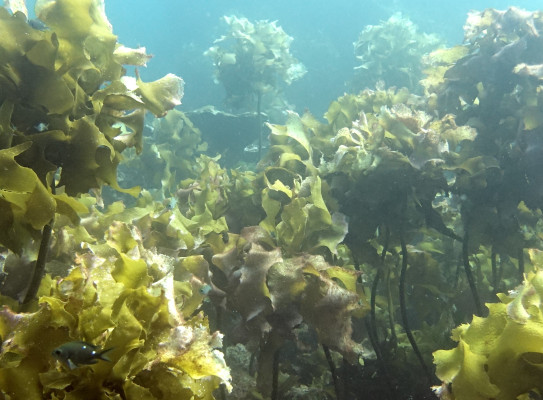Bioshields could help mitigate tsunami impact

GNS scientists are studying how well healthy ecosystems can protect coastlines against tsunamis.
New Zealand has more than 15,000 kms of coastline, with most of its population and critical infrastructure located in low-lying coastal areas vulnerable to threats from the sea such as tsunamis. Even small tsunamis of just a few tens of centimetres can produce extremely rapid and dangerous currents.
To buffer New Zealand against the destructive and deadly impacts of tsunamis, GNS scientists are examining how well nature-based solutions, such as kelp forests, act as bioshields to absorb wave energy and subdue tsunami flows.
The pilot study has shown that while bioshields did little to reduce wave height, they are effective at slowing the tsunami flow speed. Curbing flow speed can reduce the harmful impacts of strong currents sweeping the shoreline such as coastal erosion, damage to infrastructure like bridges, and sediment transport that can smother marine environments and affect water quality.
Are bioshields the answer?
Tsunamis are powerful forces that can inundate cities, damage homes and infrastructure, wreak havoc on natural environments, erode shorelines, transport sediments and cause fatalities.
Structures such as sea walls and breakwaters can go some way to countering these marine assaults, however these are costly, require maintenance and are not practical at a country-large scale.
So, what is an alternative solution to taming this powerful force of nature? Perhaps ironically, it could be nature itself.
GNS scientists are studying how well healthy ecosystems can protect coastlines against tsunamis. Known as bioshields, they can include coastal vegetation such as seaside forests, seagrasses, mangroves, kelp forests, coastal dunes and healthy estuaries with plants.
The research – what was it and what did it find?
In this pilot study, the GNS research looked at both natural and manmade tsunami defences applied to the Napier coast using computer simulated models. The models mimicked the resistant forces of each ecosystem and compared the maximum inundation extent, flow depth and speed, and where areas may have been eroded and sediments deposited.
The ecosystems included kelp forest, Pohutukawa trees, a restored estuary, a sea wall, an artificial reef and a combination of vegetation types. Across the different scenarios the most effective decelerator of tsunami currents was a combination of natural ones.
Notably, the modelled scenario showed a significant reduction in sediment transport around bridge infrastructure. Sediment is important for stabilising piles that anchor bridges to the ground. Removing it weakens the structure and increases the risk of collapse.
Turning science into action
Lead researcher and GNS Tsunami Scientist Jean Roger said the pilot study findings are expected to help local governments, planners, environmental agencies and infrastructure managers make informed decisions about natural environment management and natural hazard solutions.
“We hope our research provides decision-makers with science-backed solutions for resilience planning and land-use decisions,” Dr Roger says.
“An added co-benefit of bioshields is that they can also reduce coastal erosion from climate change impacts such sea-level rise and more frequent and intense cyclones and storms.

It’s a win-win situation. Nature-based solutions not only improve our ecosystems, they also help protect us from the impacts of natural and climate-change induced hazards in a cost-effective and sustainable way.
“Following on from this research we hope to work closely with government and industry stakeholders to come up with the most effective tailored nature-based solutions for individual areas and circumstances.”
-
Project team and funding
The GNS Science research team included Jean Roger, Uma Ashok, Annet Forkink, Laura Hughes, Xiaoming Wang, Aditya Gusman and Vinod Sadashiva.
The research was funded by the MBIE Hazard and Risk Management Strategic Science Investment Fund.
Hero image credit: Jean Roger